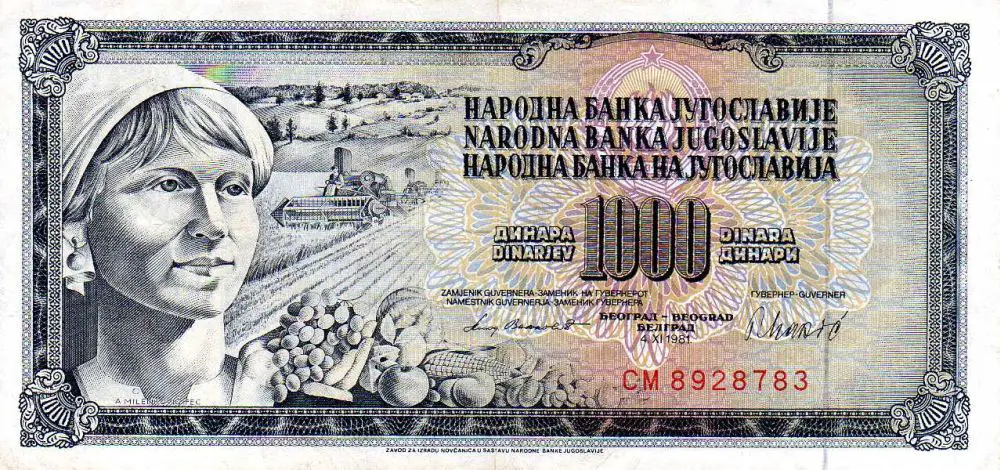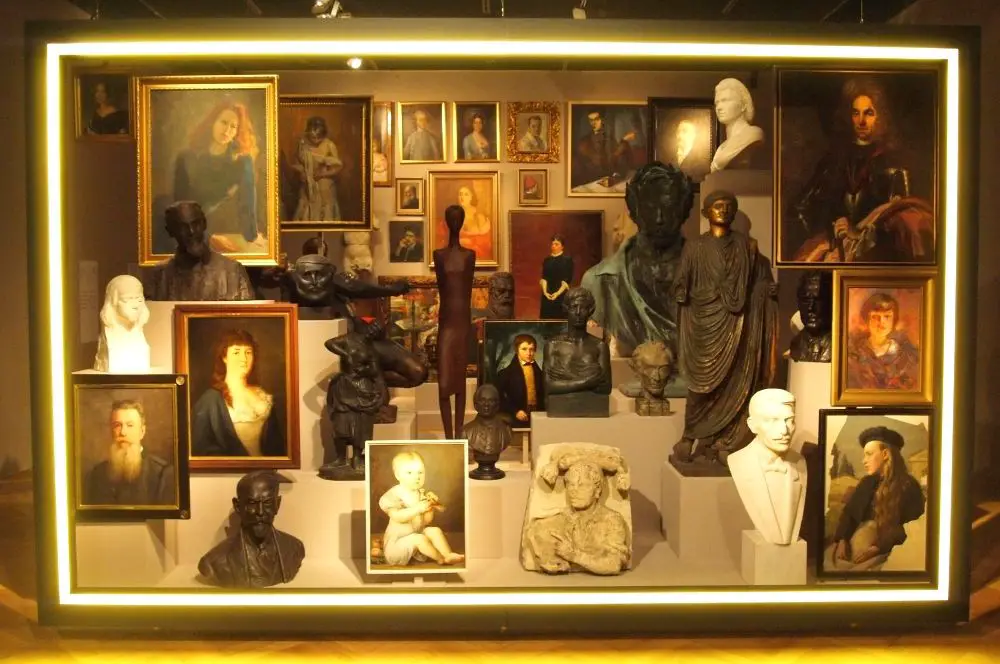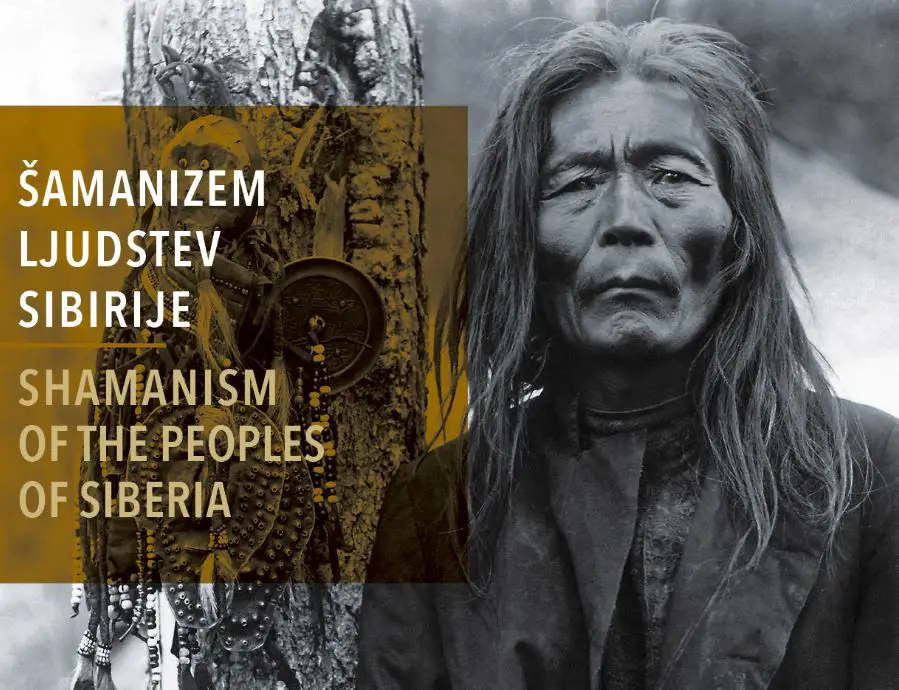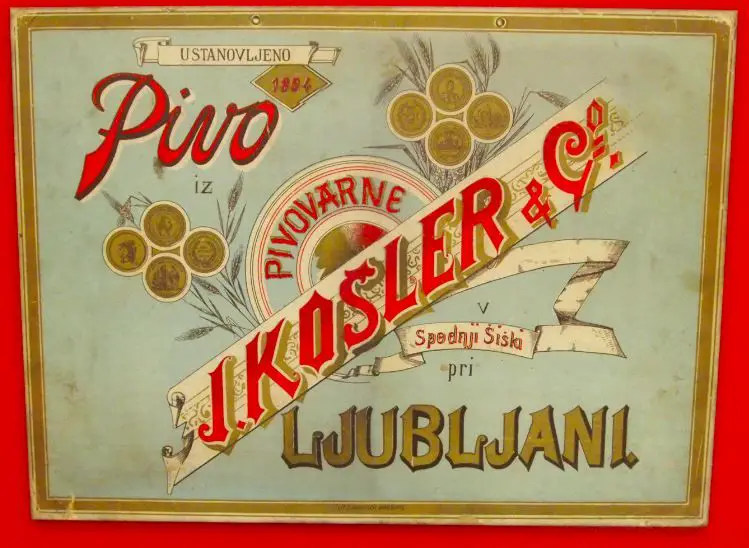Lifestyle
Get the headlines every morning here, while the events scheduled for the next week can be found here
A review of major events in the week between 26 April and 2 May, as prepared by the STA:
FRIDAY, 26 April
LJUBLJANA - The parliamentary commission in charge of overseeing intelligence and security services accused Defence Minister Karl Erjavec of abusing the military intelligence service to dismiss Brigadier Miha Škerbinc as the force commander of the Slovenian Armed Forces. Erjavec, who denies the charge, appointed Brigadier Milan Žurman Škerbinc's successor effective on 30 April.
LJUBLJANA - Foreign Minister Miro Cerar and his visiting Norwegian counterpart Ine Marie Eriksen Soreide noted the good relationship between the two countries. Norway and Slovenia "are in many ways two similar-minded countries", Cerar said.
LJUBLJANA/BRUSSELS, Belgium - Perceived independence of judges remains a sore spot for Slovenia's judiciary, according to the 2019 EU Justice Scoreboard. The country placed 22nd, based on 2017 data, a two-spot improvement over the year before. The country has considerably reduced court backlogs.
LJUBLJANA - A poll released by POP TV on the first day of the election campaign gave the joint list of the opposition Democrats (SDS) and the non-parliamentary People's Party (SLS) 12.3% of the vote, followed by the coalition SocDems with 12.2%. PM Marjan Šarec's LMŠ polled at 10.1% and the opposition National Party (SNS) at 7.2%.
BRUSSELS, Belgium - Some 75% of Slovenians who took part in the most recent Eurobarometer survey feel that being a member of the EU has benefited their country. Some 37% feel the EU is no longer on the right track, while 38% feel that way about Slovenia.
LJUBLJANA - Retail group Mercator posted EUR 1.6m in net profit for last year, an improvement over its EUR 184m loss in the year before. Sales revenue was up by 1.2% year-on-year, reaching EUR 2.18bn. Revenue from retail, the group's core business, increased by 3.2% to EUR 1.63bn.
KRANJ - The recently sold Gorenjska Banka doubled its pre-tax profit to EUR 20.68m in 2018. Net profit nearly tripled compared to the year before, amounting to EUR 17.1m, showed the annual report.
MARIBOR - The newspaper publisher Večer offloaded its entire magazine portfolio to focus on general interest media as it prepares to merge with rival newspaper publisher Dnevnik. The magazines have been sold to three companies that are part of a sprawling media empire controlled by Martin Odlazek, seen by many as one of the most influential people in Slovenia.
SATURDAY, 27 April
JELŠANE - Some 400 locals living along the border near the Jelšane crossing staged a rally demanding better border protection and rejecting the idea of their community hosting a processing centre for migrants.
LJUBLJANA - President Borut Pahor described Resistance Day as a "glorious day" that celebrates rebellion against attempts to destroy the Slovenian nation. Rebellious people risked their lives and resisted are patriots who deserve respect and admiration notwithstanding what accompanied the national liberation struggle, he said.
LJUBLJANA - Ratings agency Moody's upgraded Slovenia's outlook to stable from positive as it kept its country rating at Baa1. The outlook was changed due to the government effective response to issues exposed by the debt crisis, the Finance Ministry said.
LJUBLJANA - A total of 103 candidates running on 14 lists will vie for eight seats allotted to Slovenia in the European Parliament, showed the final tally by the National Electoral Commission. There will be 51 women on the ballot and 52 men and six lists, including by five parliamentary parties, have made women their top candidates.
SUNDAY, 28 April
LJUBLJANA - The government's approval rating improved by 3.6 p.p. in Aril compared to March to stand at 56%, showed a poll commissioned by POP TV. Support for the senior coalition Marjan Šarec List (LMŠ) grew as well, to 17% from 16.5%. The LMŠ is followed by the opposition Democrats (SDS), which lost more than one point to 14.3%, showed the poll by Mediana.
BRUSSELS, Belgium - Slovenia is seen as a stable, constructive and pro-European country which however does not fully use the potential to play the role a small country can play in the EU, Slovenia's former European Commissioner Janez Potočnik told the STA ahead of the 15th anniversary of Slovenia's EU accession.
LJUBLJANA - Data from the National Institute of Public Health (NIJZ) showed 47 people died in Slovenia in 2017 of causes related to drug abuse, seven more than in 2016. Drug-related deaths have been rising since 2013.
MONDAY, 29 April
BERLIN, Germany - PM Marjan Šarec stressed as one of the participants the informal summit on the Western Balkans that the much needed agreement between Kosovo and Serbia would have to be in line with international law, well coordinated and comprehensive. Šarec highlighted Slovenia's support to the region on its Euroatlantic path.
LJUBLJANA - The recently privatised NLB announced it will issue EUR 45m in subordinated notes with a ten-year maturity on 6 May. The bonds will have a fixed coupon rate of 4.2% in the first five years.
KRANJ - The AGM of Gorenjska Banka, which is in 98.27% ownership of Serbian AIK Banka, squeezed out small shareholders. It will pay EUR 298 a share to owners of a total of 6,166 shares, the price per share offered in the recent takeover.
LJUBLJANA - It was confirmed that the Competition Protection Agency's (AVK) approved on 25 April the sale of Slovenia-based sports equipment maker Elan to the Finnish-owned KJK fund.
CELJE - Cetis, one of the top printing companies in Europe specialising in secure documents, posted a group net profit of EUR 2.4m, down 67.6% over the year before. The group's revenue dropped by 2.2% to EUR 59.7m.
SAMOBOR, Croatia - Representatives of the largest trade union confederations of Slovenia and Croatia had their annual Labour Day get-together to adopt a joint statement which calls for prudent reflection and a broad social consensus when it comes to plans to increase the retirement age. The statement is titled 67 is Too Much.
TUESDAY, 30 April
LJUBLJANA - The Ljubljana Local Court drastically reduced the fine originally issued to the opposition Democrats (SDS) in connection to the first of its two violations of the political parties act, while only issuing a reprimand as opposed to a fine in connection to the second. The court maintains the SDS broke rules on party funding with two illegal loans taken out in 2017.
LJUBLJANA - Slovenia's annual inflation rate in April was at 1.7%, up 0.1 percentage points compared to March, while 0.8% inflation was recorded on the monthly level. Annual inflation was mostly driven by higher prices of energy, and monthly inflation by dearer holidays and footwear, the Statistics Office said.
LJUBLJANA - The Swedish news portal Nordic Monitor claimed it had obtained secret documents revealing that diplomats working at the Turkish Embassy in Ljubljana spied on a number of critics of Turkey's government and President Recep Tayyip Erdogan. The Foreign Ministry said it was not familiar with the report and did not want to comment.
LJUBLJANA - Tourism and media group DZS posted EUR 2.5m in net profit last year, an improvement over the EUR 91,000 in profit generated the year before. Sales revenue was at EUR 87m, slightly higher than in 2017.
WEDNESDAY, 1 May
RAVNE NA KOROŠKEM - Addressing a Labour Day ceremony in Ravne na Koroškem, Prime Minister Marjan Šarec said that Labour Day was not an ideological holiday but a "holiday of good people, who like to spend time together, who work hard every day and who love their country."
LJUBLJANA - President Borut Pahor urged Slovenians to cast their votes in the upcoming European elections in an interview with the STA ahead the 15th anniversary of Slovenia's joining the EU, observed on 1 May. "All of us, who see the EU as brining a future of peace, security, prosperity and the future for our children have the obligation to do something ... It is our responsibility to encourage people to vote," he said.
WARSAW, Poland - Foreign Minister Miro Cerar attended a ceremony in Warsaw marking the 15th anniversary of the accession of ten countries to the EU. He said that "the EU is strong because it is united by its diversity and differences, big and small".
THURSDAY, 2 May
LJUBLJANA - Both Slovenian journalist associations, the DNS and ZNP, took the opportunity of World Press Freedom Day, 3 May, to urge a comprehensive overhaul of media legislation. The DNS highlighted the increasing concentration of power in the hands of ever fewer media players who care strictly about business as opposed to quality journalism.
STA, 30 April 2019 - The Ažman Computer Centre was inaugurated on Wednesday at the National Institute of Chemistry. The result of years of planning, the final upgrade to the Institute's Theoretical Section will provide support to theoretical and experimental research studies, help with personnel training, and ensure high-quality performance.
Gregor Anderluh, director of the Institute, said that such infrastructure was crucial to the work of nearly all of their departments, and that by inaugurating the centre, Slovenia was successfully keeping up with the times. He also emphasised the centre's importance in facilitating research and contributing to the Institute's international presence.
The investment was worth 150,000 euros, with various departments of the Institute and the Slovenian Research Agency helping to finance its equipment.
Anderluh added that this year they plan to acquire a cryo-electron microscope that will generate massive quantities of data, highlighting the need for such infrastructure. He believes their computing capacity will most likely need to be further expanded in the coming year or two.
The Computer Centre is part of the Pregl Research Centre, founded in 2013, that houses a specialised area with a state-of-the-art cooling system of up to 175kW.
The Pregl Centre is also suitable for the future expansion of computing capacities to 5,000 computer cores and its inclusion into the national supercomputing network.
Jernej Stare, who was responsible for the upgrade, explained that the centre was now made up of 20 servers, each containing two 24-core AMD Epyc processors.
Each of the computers has 64 GB of RAM. This in total means the Institute has 960 physical cores at its disposal, each having two virtual cores, he noted.
The computer centre was named after Andrej Ažman, Slovenian-born quantum chemistry pioneer. Despite his untimely death, Ažman published 171 research papers during his lifetime, and was the first member of the Institute to have a paper published in the journal Nature, professor Jože Koller said as he gave a presentation on the scientist's life and work.
The regional aviation website Ex-Yu Aviation reports that Air France’s winter schedule for 2019/2020 will more than double the number of weekly flights between Paris and Ljubljana, rising from six to thirteen. This will see two flights a day, except for Saturdays, with the route being served by the Air France HOP! brand. Visitors to and from the French capital will also have more choice from Adria Airways, which is planning to increase its scheduled service from five days a week to seven.
STA, 28 April - Forty-seven people died in Slovenia in 2017 of causes related to drug abuse, seven more than in 2016, shows data from the National Institute of Public Health (NIJZ).
Drug-related deaths have been rising since 2013. In 2017, one person who died was a teenager aged 15-19, four were aged 20-24, and as many as 16 were older than 45.
The vast majority of the casualties, or 79%, were men, according to the NIJZ's publication on illegal drugs in Slovenia in 2017 and in the first half of 2018.
The majority of the deaths from 2017 resulted from heroin and cocaine intoxication, 18 and 14, respectively.
As many as seven resulted from other synthetic opioids, and there were eight intentional intoxications, or overdoses.
Marijuana remains the most popular illegal drug
Police processed almost 2,000 criminal acts related to illegal drugs, with cannabis accounting for the majority, followed by cocaine, heroin and amphetamines.
A survey on treatment has shown 211 persons (86.4%) who sought treatment for the first time or re-entered such treatment in 2017 did so due to problems with opioids.
Fifteen persons (6%) cited problems with cannabis as the reason for treatment.
The number of people seeking treatment for cannabis rose in 2017, after falling in 2016 for the first time in several years.
Ever since 2011, cannabis (THC) has been the drug for which patients were most often treated at the Centre for Clinic Toxicology and Pharmacology in Ljubljana.
Meanwhile, results of a survey into drug abuse has shown that 42.5% of all surveyed 17-year-olds have tried cannabis at least once, boys more often than girls.
An online survey on the use of new psychoactive substances has shown that 12% of University of Ljubljana students abuse them.
According to another online survey, carried out by the Slovenian Traffic Safety Agency in 2016, 5% of almost 3,030 persons polled were involved in driving under the influence in the 12 months before the poll, again more men and women.
In 2017, the Ministry of Labour, the Family, Social Affairs and Equal Opportunities earmarked almost 3.3 million euro for various programmes to fight addiction.
Meanwhile, the NIJZ's estimates the country earmarked a total of 10.4 million euro to deal with the issue, including for preventive programmes.
All our stories on marijuana in Slovenia (and it's changing status) and can found here, while those on recreational drugs in general are here
STA, 28 April 2019 - Vinica, a tiny border town in the south-east, is marking the centenary of a republic (Viniška republika) declared on its territory on 21 April 1919 but repressed only three days later.
Vinica residents got the idea to declare an independent state, the Republic of Vinica, from local survivors of World War I (1914-1918).
The cause for declaring it was problems surrounding the stamping of money, which caused a stir in this village in the Bela Krajina region, prompting secession.
The rebellion was repressed by the police and army of the State of Serbs, Croats and Slovenes, which emerged after the fall of the Austro-Hungarian Empire in late 1918.
President Borut Pahor, the keynote speaker at Saturday's main event, said Slovenians should proudly remember everything that had made them a sovereign nation which cherished the spirit of resistance.
Pointing to the 27 April Resistance Day, he said it was people's resistance that this public holiday and the celebrations of the Vinica Republic centenary had in common.
The people of Vinica had a sincere wish to choose their own representatives, he said, adding that such great ideas deserved admiration.
Pahor noted the Republic of Vinica was one of many events proving the idea of a democratic and sovereign Slovenia had not happened overnight but was a result of efforts of many generations.
As part of five-day centenary celebrations, a screening of a documentary on the Republic of Vinica made in 2012 by public broadcaster RTV Slovenija is scheduled for Tuesday alongside a workshop on Vinica postcards to be held at the house in which writer Oton Župančič (1878-1949), Vinica's most famous resident, was born.
April 28, 2019
Money in Slovenia has existed in three different currencies since the country declared independence on June 26, 1991, the last one being the euro, introduced on January 1, 2007.
Before the euro, the Slovenian currency was the tolar.
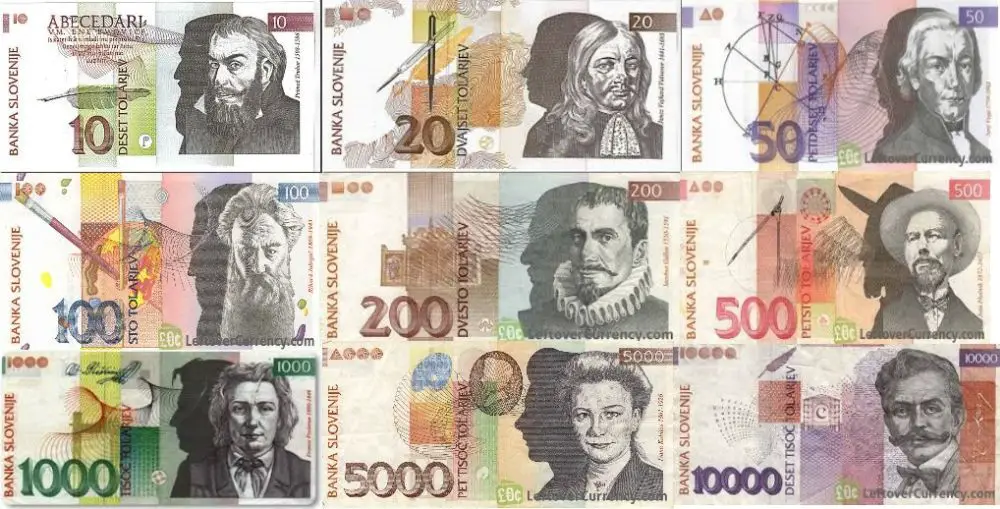
And before the tolar, Slovenia used the Yugoslavian dinar.
The dinar was a troubled currency that went through several periods of hyperinflation, each one leading to a revaluation. From the mid-1980s on, the devaluation of money also started to affect the aesthetic value of the banknotes.
Shown below are the designs of banknotes following the first revaluation of the dinar in 1965, which were in use for about 20 years.

These banknotes were relatively detailed in design, depicted anonymous workers or statues and only changed slightly over time, mostly to update the font or background details depicting the nominal value. The 500 dinar note with Nikola Tesla was introduced in 1970 and another one, a 1,000 dinar bill, was introduced in 1974. This was also the last note designed in the old classic style of dinar, when it was still worth anything.
In about 1980 I was considered old enough to be given some change and sent downtown to buy my own ice cream. In a few years of this independent ice cream consumption, I started to observe a pattern; each new summer season the price of a scoop of ice-cream doubled. I found that quite handy as I could enter the new season prepared. Until one day the whole thing became unpredictable.
Changing money in Slovenia
That actually happened around 1985, when strange ugly money started to enter circulation. To encourage people’s trust into these notes, Tito’s face was put on the first one of them.
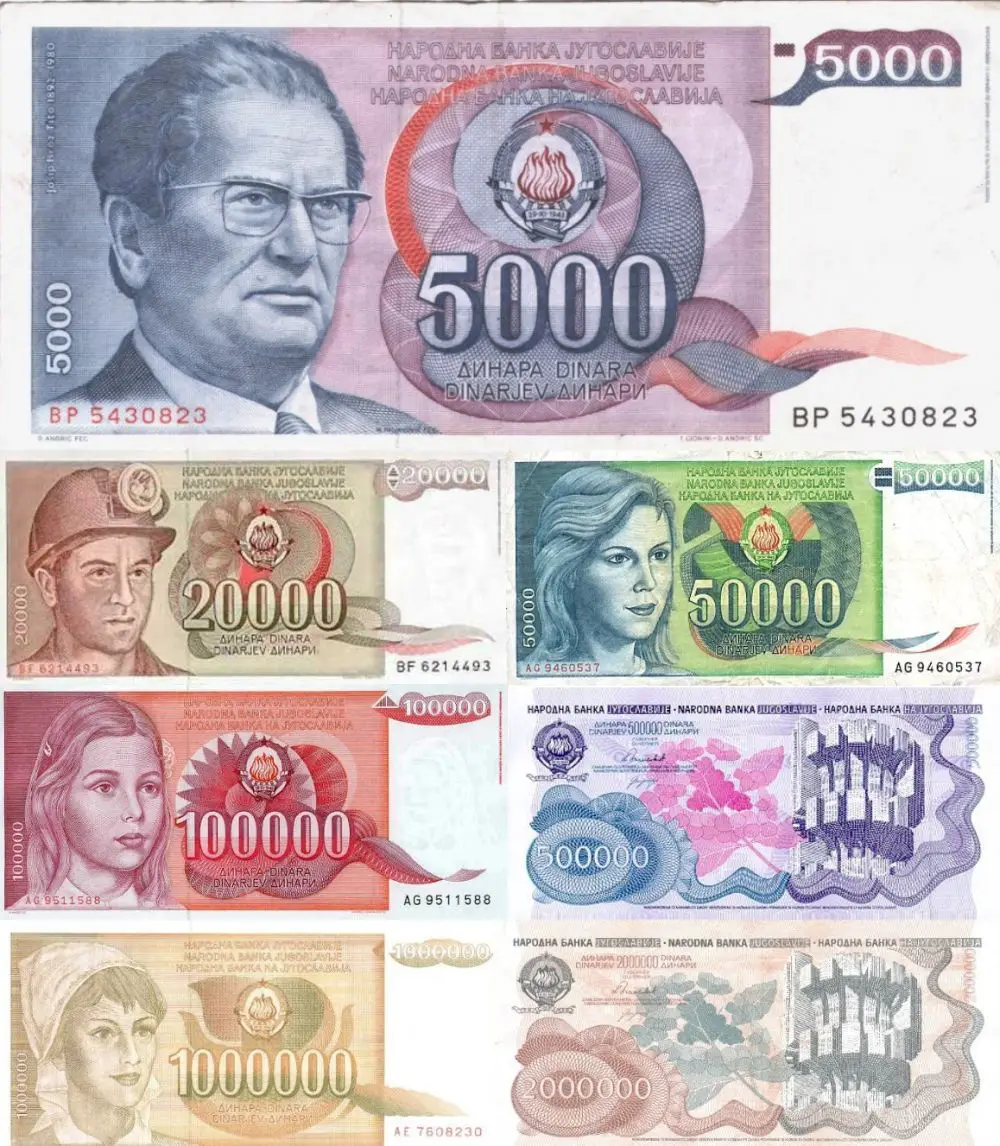
The Tito 5,000 dinar note was issued in 1985, the 20,000 bill in 1987, 50,000 in 1988, and the remaining four including the last one, the 2,000,000 dinar bill, all came out in 1989.
It seemed that money was devaluing faster than the central bank designers could draw.
The second revaluation took place on January 1st, 1990 with a new “convertible dinar” set at 10,000 : 1, basically cutting four zeros off, and from then on a whole devaluation spiral could continue.
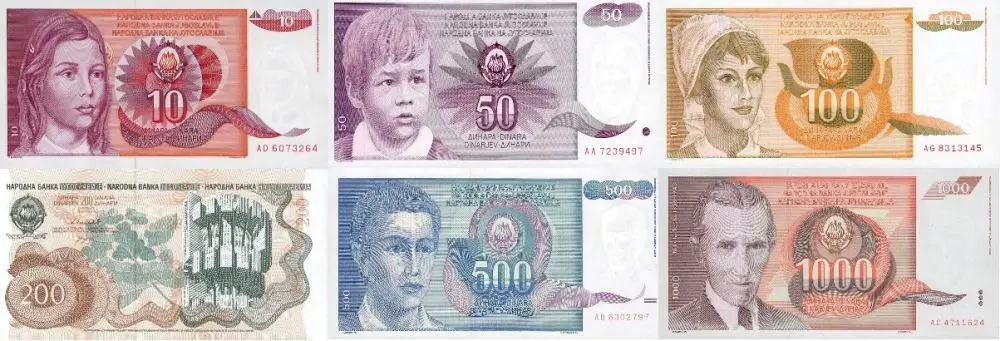
When the 5,000 bill was introduced in 1991, featuring the Yugoslavian Nobel Laureate for literature, Ivo Andrić, the country was coming to an end. This was the last dinar with writing in different languages inscribed on it, and the last one with the Socialist Federal Republic of Yugoslavia coat of arms.
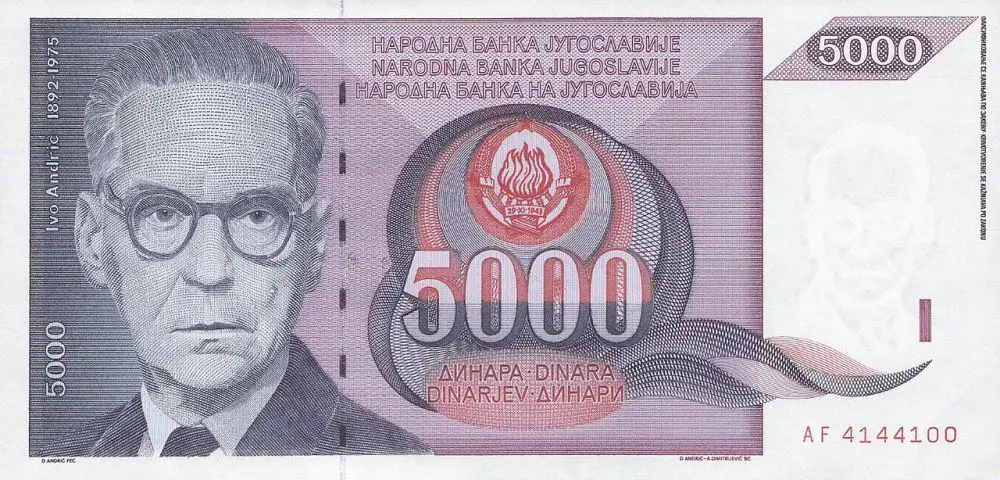
Slovenian currency, a short-lived experiment
On October 8 1991 Slovenia switched to the tolar, on December 23 Croatia introduced the Croatian dinar, on April 26 1992 Macedonia adopted the Macedonian denar, and on July 1 1992 Bosnia and Hercegovina switched to the Bosnian dinar. This was also the date of the Yugoslavian dinar’s third revaluation and the beginning of a period of massive hyperinflation, which at its peak in January 1994 amounted to 313 million % monthly inflation, meaning that prices would double every two or three days.
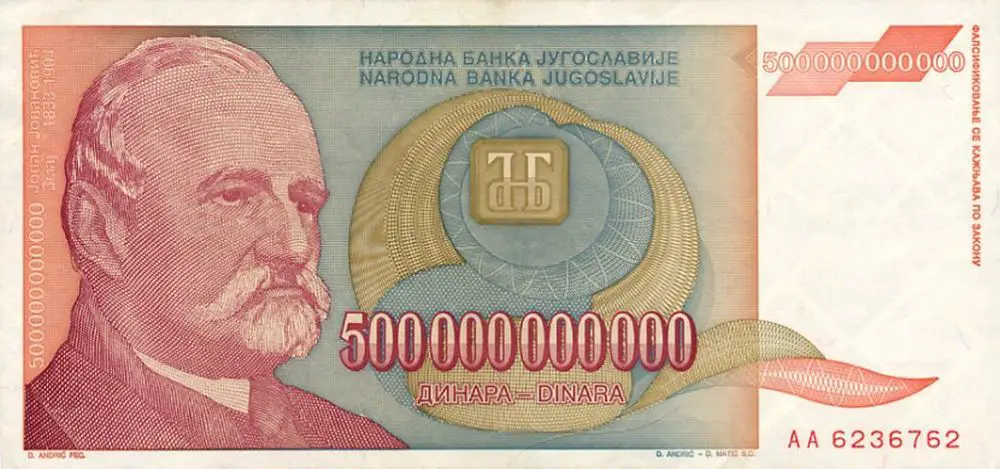
Although Slobodan Milošević blamed this monetary fiasco on sanctions imposed on what was left of Yugoslavia by the United Nations in response to Bosnian War in 1992, earlier events suggest that this time of hyperinflation might have been mostly to his own destruction of economy in his attempt at securing power. As the Federal government’s Prime Minister Ante Marković figured out as early as on January 7th 1991, the Serbian parliament secretly ordered the Serbian National Bank to issue US$1.4 billion in credit to Milošević’s friends and political supporters. This illegal plundering of the state equaled more than half of all the new money the National Bank of Yugoslavia had planned to create in 1991.
The Yugoslavian hyperinflation of 1993/94 was at the time the second highest ever recorded, until Zimbabwe pushed it to third place in 2008. The absolute winner remains the Hungarian pengő in 1946. This peaked at 1.3 x 1016 percent per month (prices double every 15 hours), and when the forint replaced the pengő in 1946, the total value of all notes in circulation in Hungary amounted to 1/1000 of one American dollar.
Keep up with the daily news in Slovenia by checking the morning headlines here
Schedule of events in the week from 29 April to 5 May 2019, as prepared by the STA:
MONDAY, 29 April
BERLIN, Germany - Prime Minister Marjan Šarec will take part in a meeting of Western Balkan leaders held at the initiative of France and Germany.
KRANJ - The annual general meeting of Gorenjska Banka will take a vote to squeeze out the remaining small shareholders following the takeover by Serbia's AIK bank.
LJUBLJANA - The two-day Global Blockchain Summit Slovenia 2019 will get under way.
TUESDAY, 30 April
LJUBLJANA - Bonfires will be lit across the country on the eve of Labour Day with the biggest event held by trade unions on Rožnik Hill above Ljubljana.
LJUBLJANA - The Statistics Office will release April inflation figures.
XI'AN China - The National Museum of Slovenia will showcase Slovenia's creativity and ancient finds at the Qujiang Museum of Fine Arts in Xi'an, until 15 November.
WEDNESDAY, 1 May
LJUBLJANA/RAVNE NA KOROŠKEM - A series of events will celebrate Labour Day, observed as a two-day public holiday in Slovenia. PM Marjan Šarec will address an event in Ravne na Koroškem (N).
WARSAW, Poland - Foreign Minister Miro Cerar will attend a celebration of the 15th anniversary of the accession of ten countries to the EU.
THURSDAY, 2 May
LJUBLJANA - Slovenia observes May Day bank holiday.
FRIDAY, 3 May
LJUBLJANA - Several Slovenian towns will join Jane's Walk 2019, a global series of urban walking tours, running until 5 May.
SATURDAY, 4 May
LJUBLJANA - The Europe Film Week will get under way, featuring free screenings of 33 European films at 12 Slovenian towns, to run until 13 June.
SUNDAY, 5 May
LJUBLJANA - Slovenia will join the Wings for Life World Run, a charity event raising money for spinal cord research.
We're moving to a new format this week, since the old, media-heavy version took too long to make for too little reward in terms of attention. That said, this guide should remain fully functoinal, with highlights noted and links to the events pages of all the major venues, so more information is always just a click or tap away.
If you're not in town for the week of this guide (29 April to 5 May, 2019) then you can see all the editions here, and you can enhance your stay in the city and impress or annoy friends and companions by learning some obscure facts about the city here, and the Castle here.
If you're looking for the biggest names and want to plan ahead, then note that Ara Malikian is playing at Hala Tivoli on 25 May, while Stožice Sports Park Arena will be hosting Sting on 4 June, while Tom Jones is playing there on 18 June.
As ever, clicking on the venue names in the list below should get you more details with regard to the time, price and location, as well as other events on at this place in whatever week you're here. Finally, if there's something you want to promote in a future edition of What's on in Ljubljana please get in touch with me at flanner(at)total-slovenia-news.com or try and find me on facebook.
- Cinemas and films
- Clubbing
- Live music
- Theatre and dance
- Harm reduction and drug testing
- Things to do with children
- LGBT+ Ljubljana
- Ljubljana Castle
- Museums and galleries
- Other things to do in Ljubljana
- Daytrips
- Getting around & miscellaneous
Cinemas and films
You can read about all the cinemas in town here, while a selection of what’s playing this week is below, and note that kids' movies tend to be shown in dubbed versions, while non-English language movies for older viewers will have Slovenian subtitles. Parents should also pay attention to Kinobalon, which is Kinodvor's regular weekend series of film screenings and events for children, from babies on up, with special parent/child events, "first time in a cinema" screenings, and babysitting. Learn more about it here, and see the current schedule here.
Kinodvor – This is an arts cinema, not far from the train station, that shows new features as well as hosting the occassional festival.
Kinoteka – And not far from Kinodvor you can find this revival cinema, which shows art house classics along with some deep dives in the archives.
Kino Bežigrad - A relatively small theatre, but one which usually has the biggest of the new releases.
Kolosej - The multiplex out at BTC City Mall shows all the big movies, with well over a dozen titles on the schedule, although note that there are far more movies than screens, so some of the older ones may only be playing once or twice a week.
Komuna – The cinema in a basement behind Nama department store shows two or three different features a week, usually including the biggest titles.
Clubbing
Compared to some European capitals it can seem that nightlife in Ljubljana ends rather early, especially along the river, but there are still bars that stay open late and clubs were you can dance until dawn, and perhaps the best place to stumble across something interesting is the legendary Metelkova. Be aware it's a grungy kind of place and not for all tastes, but also that there's considerable variety to found within the various clubs there, from death metal to electropop, gay cabaret to art noise. You can read "the rules" of the place here. And if you're curious about how the place started then read our story, and look at some pictures, about last year's 25th anniversary.
Božidar - DJ events aren't too common here, but when they happen they often have a big name.
Channel Zero – DJs shows here include regular dub nights as well as electronic music.
Gala Hala – Another Metelkova venue, you can sometimes hear bhangra and Bollywood here, but more often funk, hip hop, breakbeat and so on.
Klub Cirkus – The more commercial end of clubland, and a venue that aims to serve the student party scene. Expect house, anthems, and bangers.
Klub K4 – The home of techno, old and new, along with various other electronic genres,
Koncertna Dvorana Rog – There are irregular DJ sets at this underground (not literally) venue at the far end of Trubarjeva cesta, and they range from techno to goa to drum'n'bass.
Orto Bar – 80s and 90s throwback nights can often be found here, along with rock-based DJ sets.
Live music
Balassi Institute – Free Hungarian music, when available, from the Hungarian cultural institute just a short walk downriver from Dragon Bridge.
Cankerjev dom – The main arts venue in the country hosts classical, opera jazz, folk and occassinally pop.
Cvetličarna – Regional pop and rock concerts can be found here.
Channel Zero – This Metelkova venue sees live shows from punk and rock bands, as well as others.
Gala Hala – Another Metelkova venue with indie bands of various styles.
Kino Šiška – One of the top live venues in the city, with a varied programme that include indie, rock, pop, experimental, hip hop, and so on.
Klub Gromka – Live music is often metal, from sludge to stoner, death to thrash, while punk bands also appear, as do others.
Križanke – The venue that hosts the Ljubljana Festival often has classical music, and some rock, in the open air.
Ljubljana Castle – Jazz, funk and pop every Friday night.
Orto Bar – The home of live rock, metal, punk and other guitar-based genres.
Pinelina dnevna soba – LIve music is rare here, but it does happen.
Slovenska filharmonija – Classical music in the centre of town.
SNG Opera and Ballet - As the name suggests, here you'll find the best of opera and ballet in the country.
Španski borci - While dance is more common here, they also have some contemporary and experimental music shows.
Theatre and dance
Cankerjev dom -- The main arts venue in the county has some of the biggest shows.
Gledališče IGLU - IGLU Theatre – Saturday night this group is usually putting on an English improv show somewhere in town, but it’s generally promoted after this is written, so check the Facebook before putting on your shoes.
Kino Šiška – One of the top live venues in the city also hosts some dance performance, often of the more experimental variety.
Mini Teater Ljubljana – The English schedule of varied performances, for adults and children, for the month is here.
Ljubljana Puppet Theatre - Puppetry has a long and noble tradition in Slovenia, and you can see performances for children and adults (including non-puppet shows) drawing from the Theatre's rich repetoire as well as new productons.
SNG Opera and Ballet - As the name suggests, here you'll find the best of opera and ballet in the country.
Španski borci - The home of contemporary dance (and the EnKnapGroup) in Slovenia.
Pocket Teater Studio – There are regular flamenco evenings at perhaps the smallest venue town, but note that the number of seats is very limited, and thus you should make a reservation via This email address is being protected from spambots. You need JavaScript enabled to view it. or 070 325 522.
Harm reduction and drug testing
Drogart is an organization that aims to minimise harm on the party scene, and offers drug-testing services and reports on their webpage. It’s in Slovene, but you can Google translate it or work things out yourself, and our story on the group is here. You can find the latest warnings on fake drugs and high strength pills and powders (in Slovene) here. However, be aware that all the usual drugs are illegal in Slovenia. CBD is legal, though, and our retailer of choice can be found on Trubarjeva cesta - read more about Sena Flora here.
Things to do with children
You can find our Top 12 list of things to do with kids in Ljubljana here. If want to read more about the philosophy behind the wonderful House of Experiments look here, while our trip to the Museum of Illusions is documented here, and there’s always riverside walks, pizza and ice cream. With regard to the latter, take a look at our guide to six places that serve good ice cream in winter, and thus are serious about the dessert.
Mini Teater Ljubljana – The season sees a lot of puppet performances for children, in Slovene, at this theatre not far from Križanke. The English schedule for the month is here.
Ljubljana Puppet Theatre - The puppet theatre near the Central Market and next to the Castle funicular has a full programme or shows, for children and adults, with the schedule here.
LGBT+ Ljubljana
If you want to learn more about Ljubljana Pride, then take a look at our interview with its president here. If you're looking for more general links on "gay Slovenia", including a history of the scene and various projects, then you can find that here, while our stories about the community can be found here.
Klub Monokel – This lesbian bar in Metelkova is open every Friday, although sometimes there are other events
Klub Tiffany – And the gay bar next door is also open on Fridays, while every Monday until June 2019 there's tango at 18:00. Other things coulds also be planned, so click on the name to find out.
Pritličje – This seems to be the only "always open" LGBT-friendly cafe / bar / events space in town, and perhaps the country, so it's a good thing it's such a good one, open from morning to night, and with fliers and posters letting you know what's happening outside the narrow confines of, say, a general interest online what's on... guide.
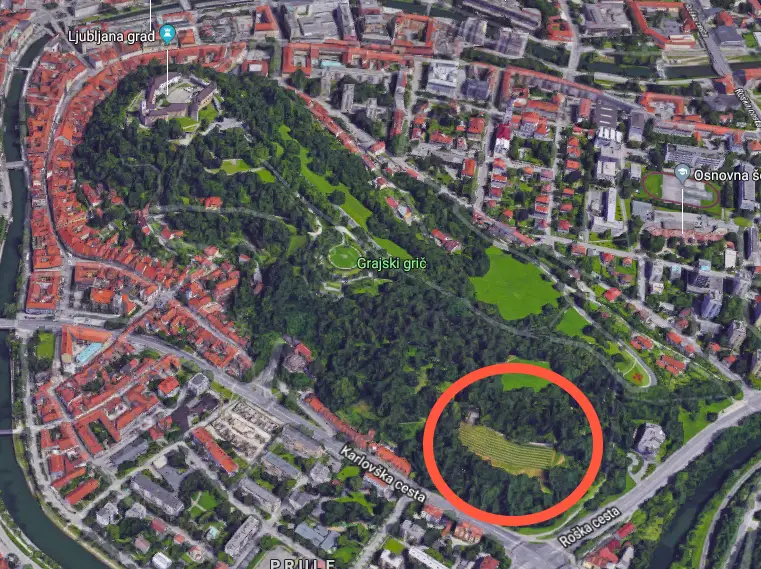
Screenshot from Google Maps, showing the location of the Castle vineyard
Ljubljana Castle
The city’s main attraction is said to be the top tourist draw in the country overall, and to my mind it earns a spot near the top just for the history and views. But beyond that the current owners, the City of Ljubljana, have laid out a varied, interesting and enjoyable programme of events, one that rewards regular revisits.
I try and get up there every Saturday morning to clear my head and move my feet on the trails, and never tire of that end of the hill. At the other end, where the Castle sits, there’s a lot more than fresh air on offer. There are guided tours, restaurants, a café, Castle museum, puppet museum, a Watchtower you can climb to the highest point in the city, art shows, dances, live music, movies under the stars, festival days and more – enough to reward multiple trips up the hill through the year. All of these activities and events can be found on the Castle website, while on TSN you can see “25 things to know about Ljubljana Castle” here, and “Ten Ways to Enjoy Ljubljana Castle” here.
Museums and galleries
Most public galleries and museums are closed on Mondays, although not the National Museum, and - as noted at the start
Cankerjev dom – The 13th Slovenian Biennial of Illustration is here until May 19th, while a free to see show called Subterranean Worlds, showing cave photography, runs from April 24th until June 16th.
Plečnik's desk. Photo: JL Flanner
Plečnik’s House is worth a visit if you want to learn more about the architect who gave Ljubljana much of its character, and it's also in a really nice part of town, Trnovo, just a short walk or cycle upriver. Read about our guided tour here.
Balassi Institute – The Hungarian culture centre has Interlacement – exhibition of Éva Farkasvölgyi and Žiga Okorn, starting April 16th. Free to enter, this venue is next to a Spar and Hofer, and not far from Dragon Bridge, and always has something interesting going on. Learn more here.
City Museum – The Museum in French Revolution Square an interesting permanent exhibition on the history of Ljubljana, from prehistoric times to the present day, with many artefacts, models and so on that bring the story alive.You can read about my visit here.
The Faces of Ljubljana in the City Museum. Photo: JL Flanner
International Centre of Graphic Arts – Starting March 22 and running until May 19 is Photographic Images and Matter: Japanese Prints of the 1970s and Japan, Yugoslavia and the Biennial of Graphic Arts: Documents of Collaboration. One of the images promoting the show is shown below.
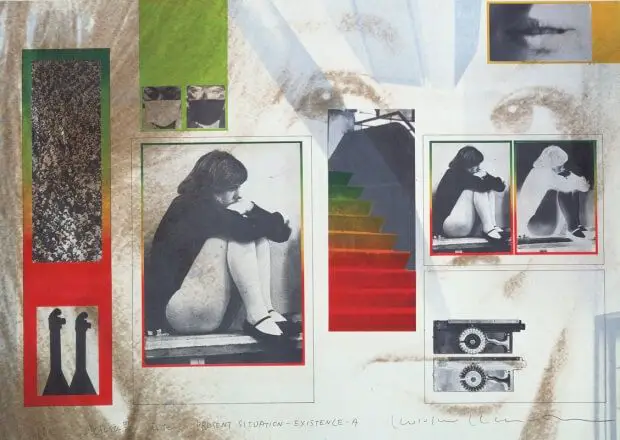
Kosuke Kimura: Present Situation – Existence A, colour and silkscreen, 1971.
MAO – The Museum of Architecture and Design has much of what you'd expect, along with some temporary shows and a good cafe. Until May 19 there's Tendencies: Architecture and Urban Planning in Celje, 1955–1985.
Moderna galerija – The main branch of this gallery, to be found near the entrance to Tivoli Park, has a good collection of modern art, as well a nice café in the basement. Opening Thursday, April 25th, 20:00, The Visual Arts in the Kingdom of Yugoslavia, 1929–1941, which then runs until September 15th 2019. This offers “an overview of painting, sculpture, printmaking, drawing, photography, and film from the time the king's dictatorship was set up (6 January 1929) to the beginning of World War II on Yugoslav soil (April 1941)” - you can read more about it here. The museum's Metelkova branch also has a big new show, runing until at least September 2019, an the art of the Non-Aligned Movement, with an example shown below.
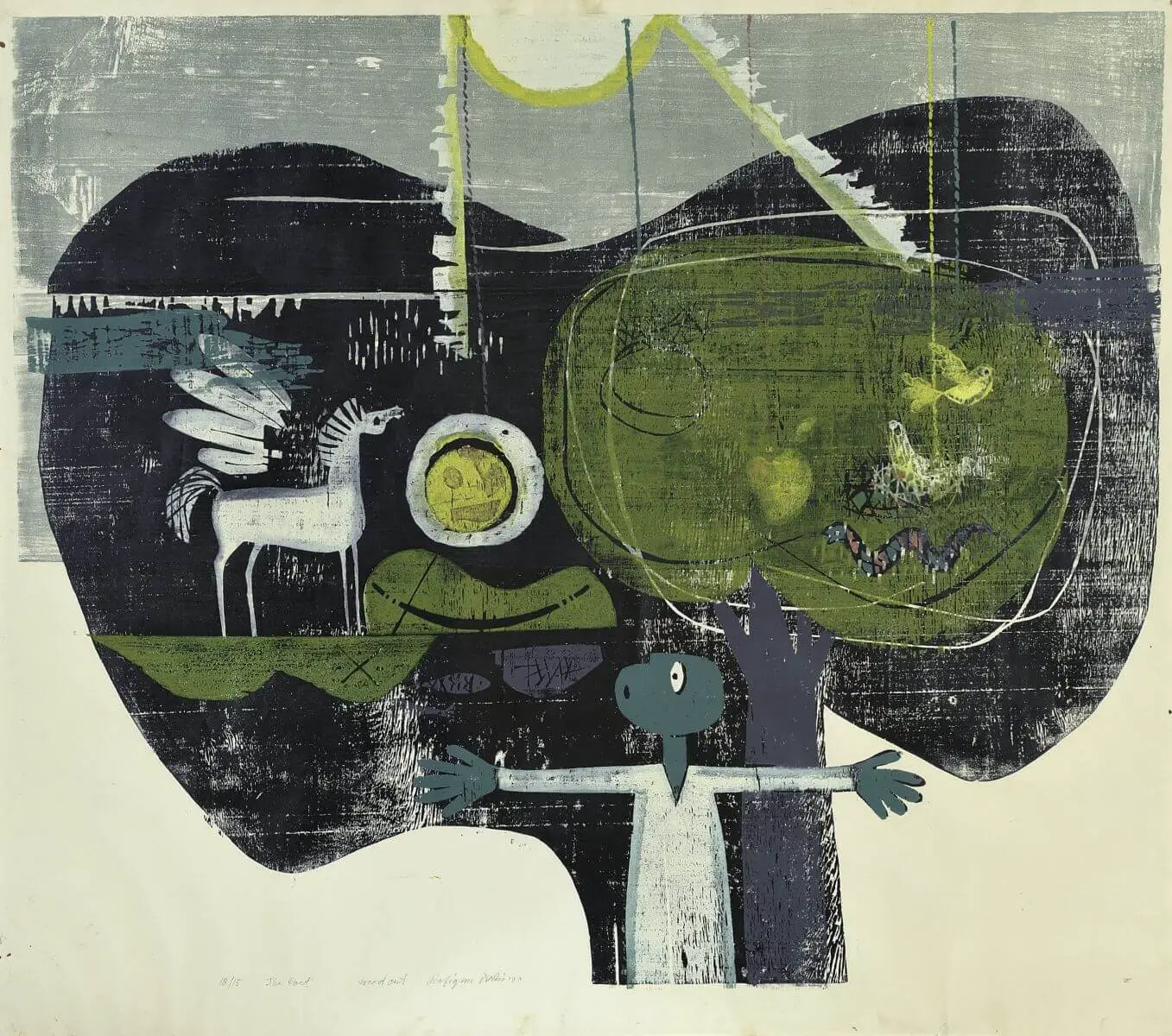
Rafikun Nabi: Poet, 1980, print, 96.5 x 110 cm. Courtesy of the Contemporary Art Center of Montenegro. On display at the Metelova branch of the Moderna galerija
National Gallery – The country’s main gallery has “the best” of what’s on offer from the Middle Ages to non-contemporary modern visual arts, and is in a great location for exploring other areas, just by Tivoli Park and opposite the main branch of the Moderna galerija. You can read about our visit to the room containing sacred art from the Middle Ages here.
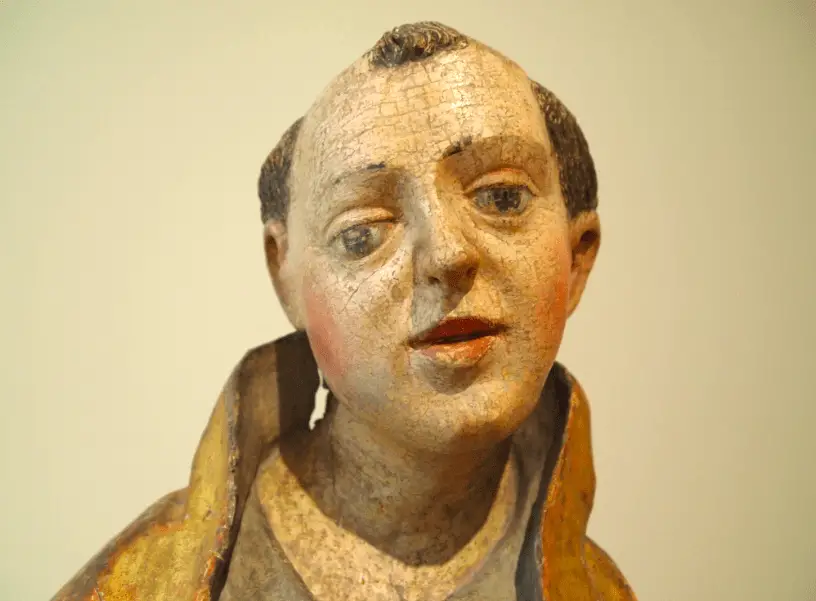
JL Flanner
The real Robba Fountain can be found in the entrance to the National Gallery - the one you see in the Old Town is a genuine fake, as seen below and reported here.
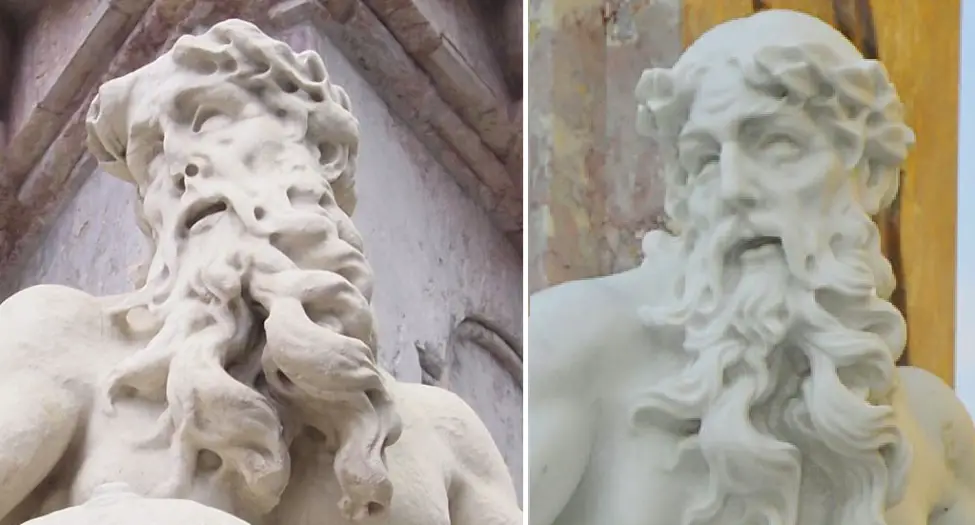
Photo: JL Flanner
National Museum of Slovenia – There’s plenty to see in the permanent collection here, from Roman times, Egypt and more. Meanwhile, the museum's Metelkova branch, located between one branch of the Moderna galerija and the Ethnographic Museum has some rooms on Church art, furniture and weapons, with the latter including more guns than you'll see anywhere else in town, and quite a thrill if coming from a nation where such objects are not household items.
Natural History Museum – On until the end of June 2019 is Our Little Big Sea, which takes a look at the oceans.
National Museum of Contemporary History - Tucked away in park Tivoli, in addition to his permanent collection will be showing In Search Of Freedom: 1968-2018 until 16 August.
Slovene Ethnographic Museum – The museum currently has a temporary show on Bees and Beekeeping, on until June 16 2019, as well two permanent exhibitions. One of these is called Between Nature and Culture, and has a great collection of objects from Slovenia and around the world, well worth the trip up to the third floor to see it (as recounted here). From April 18 until October 19 (2019) you can also see a show called Shamanism of the Peoples of Siberia, from the Russian Museum of Ethnography, Saint Petersburg. The place is located near the newer branch of the Moderna galerija and Metelkova. You can read about this fascinating show here.
Union is "the Ljubljana beer", but now both it and Laško are owned by Heineken. There are many local brews on offer around town, though, if you want to explore IPAs, stouts, wheatbeers, sours and so on Photo: JL Flanner
Union Experience – The Ljubljana-based brewer has a museum showing the history of the company, with the ticket also including access to part of the factory and a few samples of the product. You can read about our visit here.
Volčji Potok Arboretum - Running until 3 November you can see a large collection of cacti here.
It's not a formal museum, but if you're interested in "Yugo-stalgia" then you'll enjoy a trip to Verba, a small, privately run space that's crammed with objects and pop culture items from the era, and is conveniently located at the start of one of the short walks to the castle. It's also a great place to take pictures, if you leave a donation, and you can read more about it here.
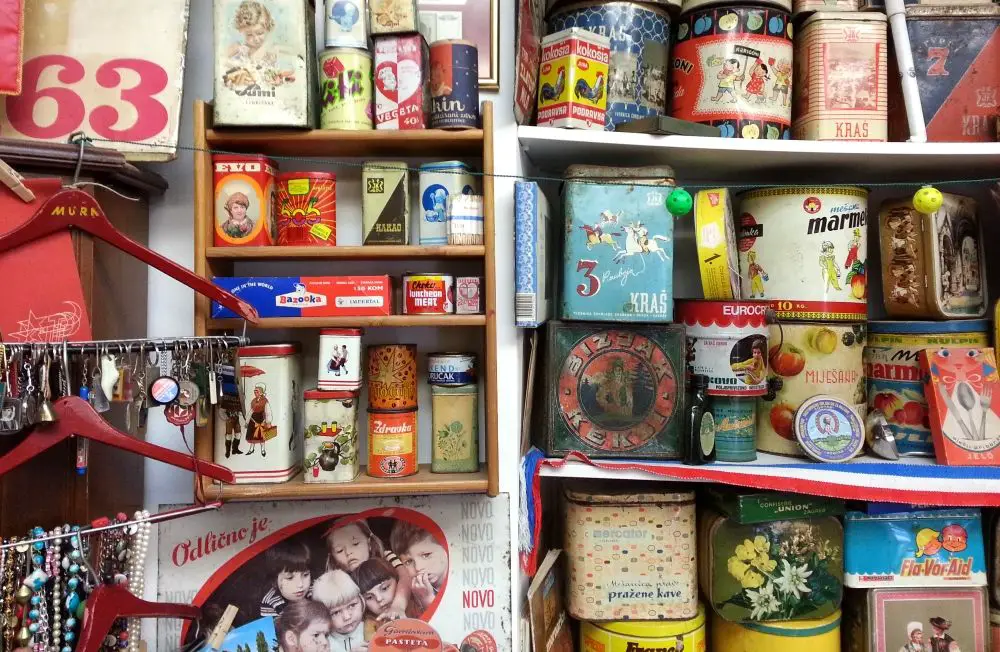
Verba. Photo: JL Flanner
Alternative Ljubljana isn't a museum or gallery, as such, but instead turns the city streets into a museum and gallery. Learn more about their tours of street art, history and LGBT Ljubljana here.
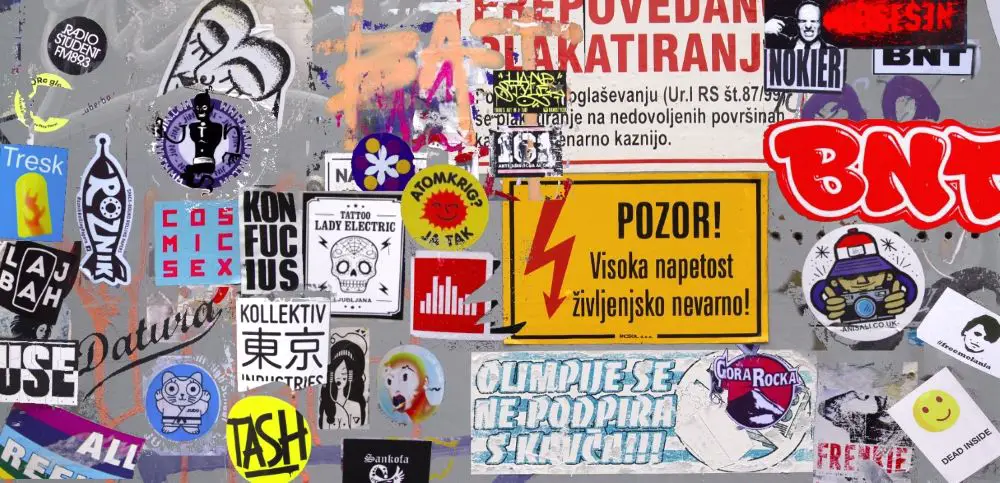
Photo: JL Flanner
Other things to do in Ljubljana
Open Kitchen brings market stalls selling food and drink from some of the best restaurants in town every Friday, from 11am to 11pm, in the square between the cathedral and the river - just follow your nose and the crowds. Read more about it here.
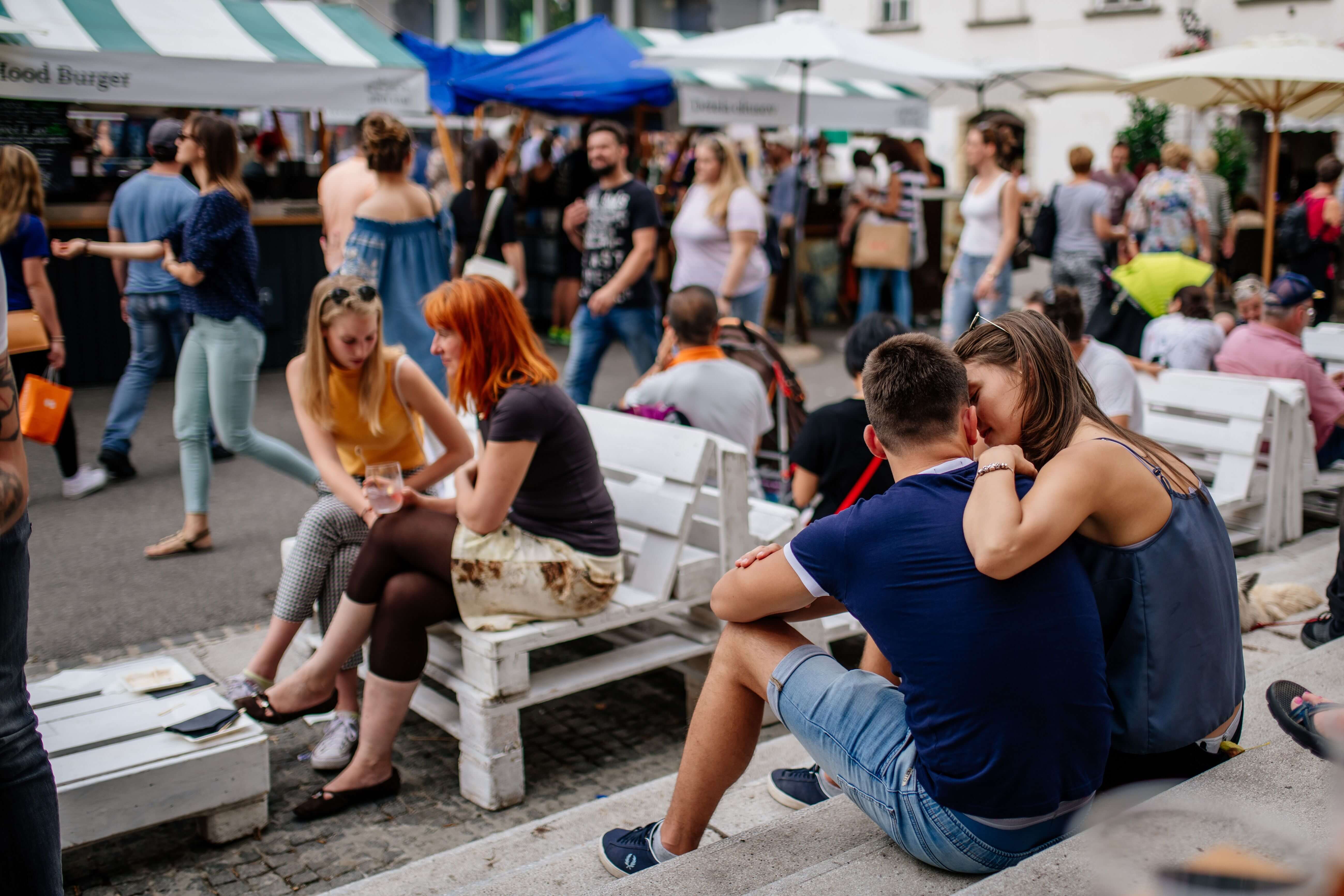
Photo: Open Kitchen
If you'd like to spend an evening painting with others, then take a look at Design with Wine, which organises painting parties on Trubarjeva cesta,
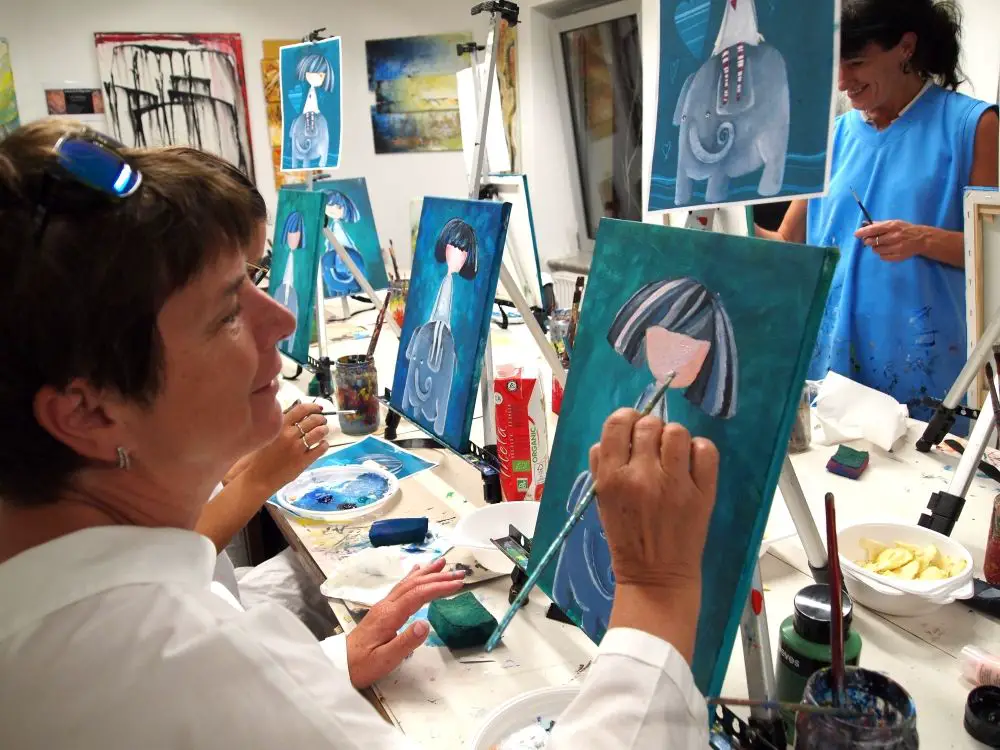
If you want to see some antiques, then check out the wonderful Antika Carniola, as discussed here. The man behind it, Jaka Prijatelj, has a fine eye for life on this street, as you can see on his Facebook account.
Photo: JL Flanner
If you’re in town and want to go jogging or walking in nature, why not take another look at the Castle, with a brief guide to the trails here. If you want something bigger, head to Tivoli Park.
And if you're bored with the Old Town, why not take a walk, cycle or boat ride to nearby Špica and enjoy the riverside life. Learn more about that here.
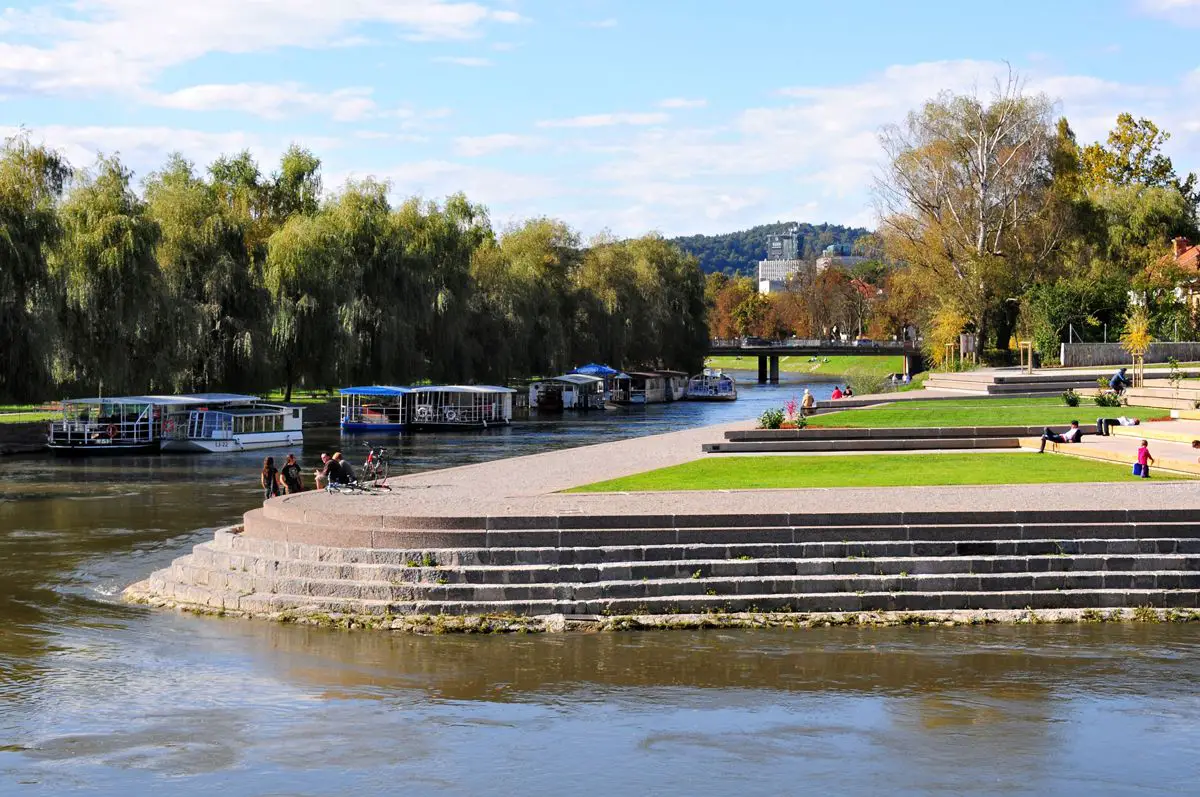
visitljubjana.si
![]()
maxpixel.net, public domain
Want to stretch and breath? Then check out our list of drop-in yoga classes for tourists, visitors and the uncommitted. If you're heading to the coast, check out our interview with a yoga teacher who offers breakfast sessions there, while if you're staying in town (or nearby) and want to try some "family yoga" then you can learn more about that here and maybe get your kids to calm down a moment or two.
Prefer to have someone else stretch you? The check out the totally legit massages you can get from Sense Wellness - either in one of their spas or in you home, office or hotel. (And - to repeat - these are legit and non-sexual in nature)
There are some golf courses near Ljubljana, but even ones further away are not far, as seen in our list of all the golf courses in Slovenia.
![]()
Photo: maxpixel.net, public domain
Daytrips
Most of Slovenia is only a few hours from Ljubljana, and you can easily visit Lake Bled, Lipica Stud Farm, Postojna Cave, Predjama Castle, the coast and other locations, while if you'd like to take a photo of from that bench in Bled, then you can learn how to get there here. If you’re looking for something more ambitious, then check out our recent guide to the 17 members of the Association of Historical Towns of Slovenia
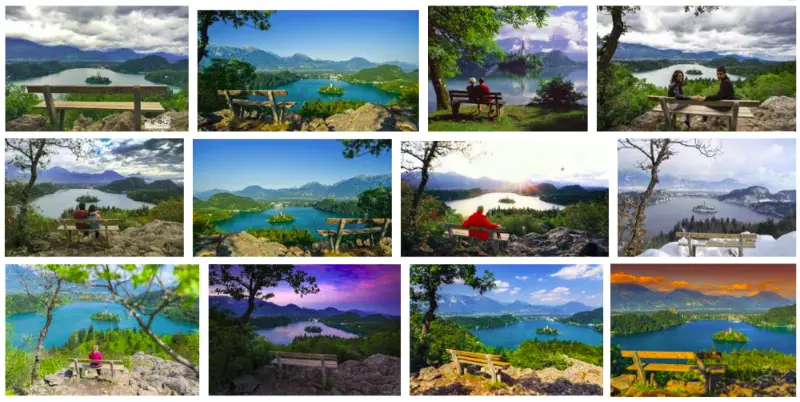
Photo: Google Image Search
Getting around & miscellaneous
If you want to get a Ljubljana Tourist Card, which gives you travel on the city buses and entry to a lot of attractions, then you can read more about that here, and if you want to use the bike share system, as useful for visitors as it is for residents, then you can learn more by clicking this. Visitors with reduced mobility will be pleased to find that downtown Ljubljana is generally rated as good with regard to accessibility, and that there’s a free, city-sponsored app called Ljubljana by Wheelchair highlighting cafés, attractions and so on with ramps, disabled bathrooms and Eurokey facilities, which you can read about and download here. Manual wheelchair users can also borrow, for free, an attachment that will motorise their equipment, as reported here.
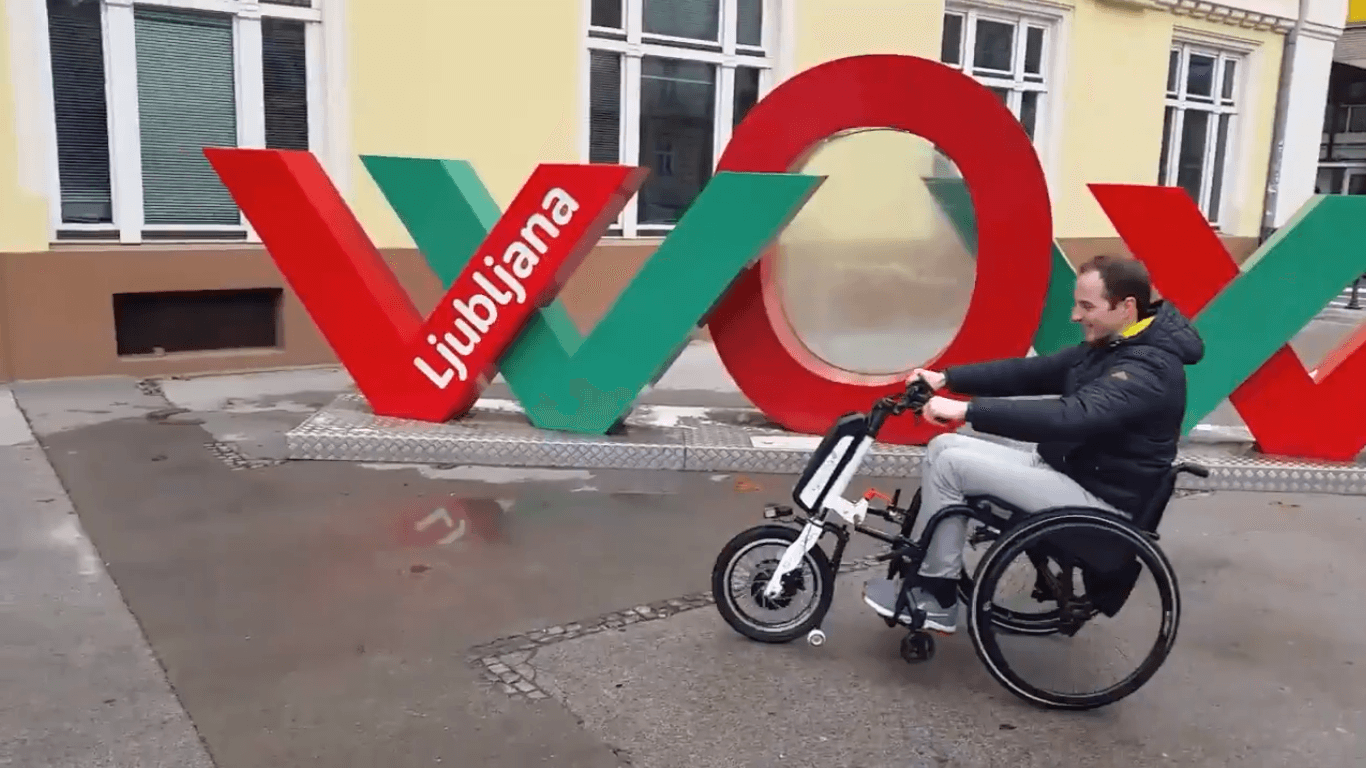
Screenshot from a Twitter video
If you’re driving into town and don’t know where to part, our guide to how to park in Ljubljana is here.
There aren't many places to eat after midnight, and most of them are by the train station, as reported here.
Want / need cigarettes but the stores have closed? Here's an incomplete list of bars downtown that will satisfy your craving for the demon weed. While if you’re having trouble with the ATMs then here’s a guide to the Slovene you’ll see on screen. If you get a hangover then find out where to get paracetamol (and prescription drugs) in Ljubljana here, while details on emergency birth control can be found here.
Ljubljana is a small and relatively safe city, but if need to contact the police then there’s a special number for foreigners, and that’s 113.
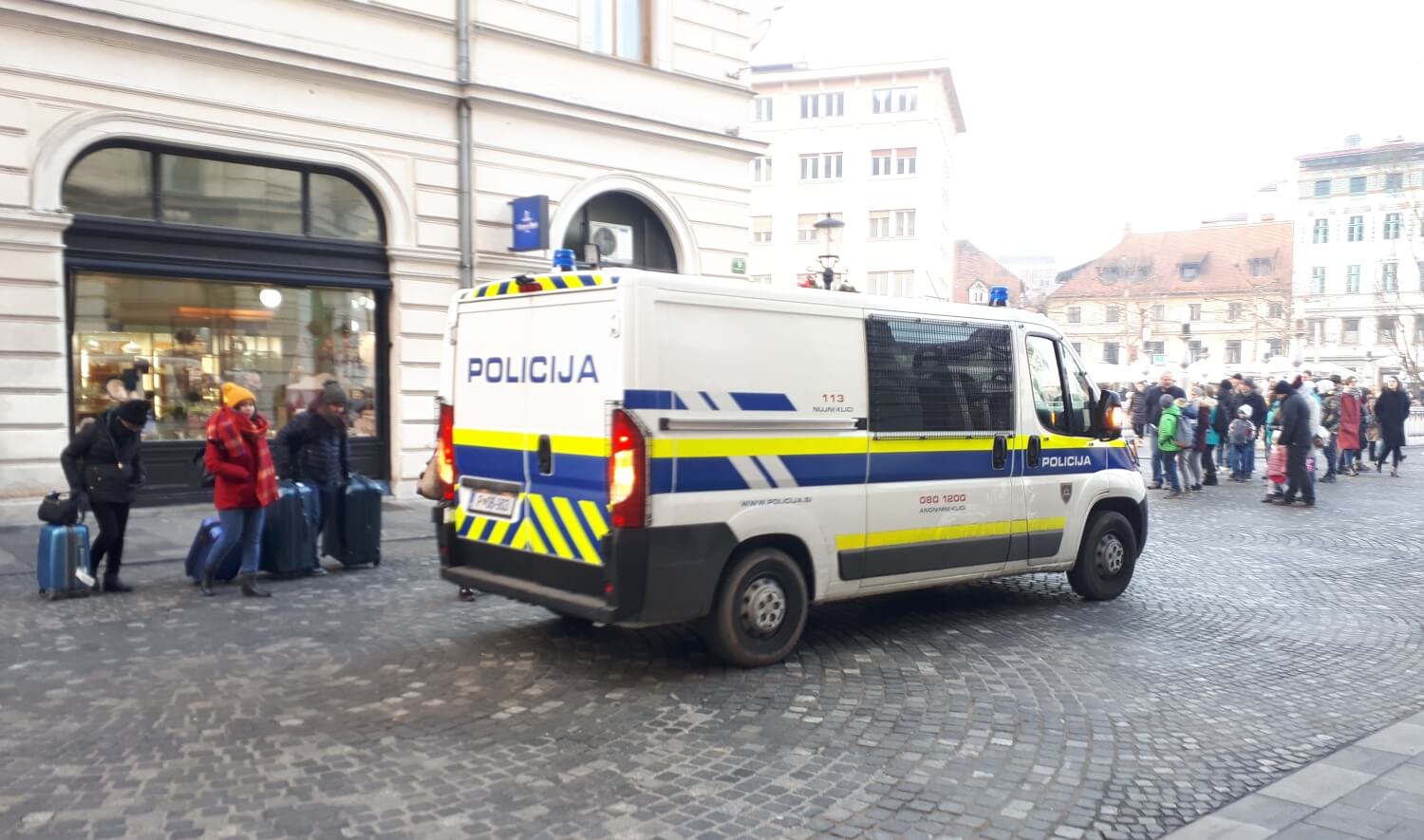
Photo: JL Flanner
STA, 25 April 2019 - Paintings, sculptures, prints, drawings, photographs and films created by more than 130 authors between 1929 and 1941 in the Kingdom of Yugoslavia will be displayed at the Moderna Galerija in Ljubljana until 15 September, 2019.
On the Brink: The Visual Arts in the Kingdom of Yugoslavia (1929-1941) provides an overview of the visual art from the start of the reign of King Alexander I on 6 January 1929 to the beginning of World War II in Yugoslavia in April 1941.
Divided into five sections, it deals with five topics through different works of art and presentations. The show, the gallery's most ambitious event this year, will be accompanied by more than 20 film screenings.
In the section exploring intimacy and the inner world, works by major Serbian and Slovenian painters are put on show, the second section is dedicated to landscapes.
The third section, focussing on contrasts, is the central part of the exhibition and features a painting by Serbian Petar Dobrović depicting journalists of the Danas magazine.
It also presents a clash on the left between Croatian writer Miroslav Krleža and Marko Ristić, a representative of Belgrade's surrealism.
The fourth section is dubbed People. According to curator Marko Jenko, this room is very chaotic, presenting people from cities and the countryside, mainly through reportage photography, which was very popular at the time.
The final part of the exhibition presents Yugoslavia's ties between the two world wars through the first two official presentations of the Kingdom of Yugoslavia at the Venice Biennale in 1938 and 1940.
According to Moderna Galerija director Zdenka Badovinac, the historical context of the period is presented through excerpts from a 1934 travelogue by Louis Adamič, The Native's Return.
Slovenian-US writer Adamič presented the complex situation in the kingdom at the time through his encounters with a variety of people, including Croatian sculptor Ivan Meštrović, Dobrović and Krleža.
He was also received by King Alexander I, one year before his assassination in Marseilles.
Adamič portrayed the Kingdom of Yugoslavia as a country on the brink, a country of stark contrasts, caught between old, premodern customs and the grip of capitalism, with a premonition of its imminent end in a broader European and global context, the museum of modern art says.
The exhibition is open until 15 September.
Get the headlines every morning here, while the events scheduled for the next week can be found here
A review of major events in the week between 19 and 25 April, 2019, as prepared by the STA:
A review of major events in the week between 19 and 25 April, 2019, as prepared by the STA:
FRIDAY, 19 April
LJUBLJANA - The newspaper Dnevnik reported the government had appointed career diplomat Vojislav Šuc Slovenia's new ambassador to Croatia. Before he replaces Smiljana Knez, he must be quizzed by the parliamentary Foreign Policy Committee and receive Croatia's approval.
LJUBLJANA - Social partners on the Economic and Social Council agreed the Labour Ministry would draft a new social pact by the end of May, based on three proposals by employers and one by trade unions. They would like to reach a consensus by the end of the year so that a new social pact could take effect in 2020.
LJUBLJANA - Slovenia's general government surplus in 2018 was 34 million euro higher than initially calculated by the Statistics Office in March. It reached 337 million euro, equivalent to 0.7% of GDP. The country's debt amounted to 32.23 billion euro, or 70.1% of GDP.
LJUBLJANA - Tourism contributed 5.7 billion euro or 12.3% to Slovenia's GDP in 2018 and provided jobs for 110,700 people or 12.8% of all jobs, showed a report by the World Travel and Tourism Council.
TORONTO, Canada - Slavoj Žižek, the internationally acclaimed Slovenian philosopher, and Canadian bestselling author and psychologist Jordan Peterson, faced off their views on capitalism and Marxism. The long-awaited debate at the packed Sony Centre for the Performing Arts saw Peterson defend capitalism, arguing it also created wealth for the poor, while Žižek pointed to climate change as one instance of what is eating capitalism inside out.
SATURDAY, 20 April
LJUBLJANA - The newspaper Dnevnik reported that the Higher Court had reduced the fine imposed by the Ljubljana Local Court on the opposition Democrats (SDS) over an illegal loan of 60,000 euro from 20,000 to 4,200 euro. It also reduced the fine imposed on party leader Janez Janša from 2,000 to 500 euro.
SLOVENSKA BISTRICA - Impol, a Slovenian maker of aluminium products, obtained the EN 9100 standard certificate proving its compliance with the international quality standard for the aerospace industry which should enable it to get into the demanding market of top-quality products.
LENART - Local authorities in Lenart urged suspension of the Salomon waste sorting operation in the north-east town after waste deposited there went up in flames twice in a week, on 13 and 19 April. Unofficial information suggests the fires were caused by a spontaneous combustion.
SUNDAY, 21 April
LJUBLJANA - President Borut Pahor and Foreign Minister Miro Cerar condemned bomb attacks in churches and hotels in Sri Lanka, which killed more than 300 people, and expressed condolences to the families of the victims.
GLASGOW, UK - Pia Babnik, a 15-year-old Slovenian golf player, won the Helen Holm Scottish Women's Open Championship with a seven-shot win over France's Charlotte Bunel, affirming her status as one of the best up-and-coming female players in Europe.
TUESDAY, 23 April
BRDO PRI KRANJU - President Borut Pahor and Foreign Minister Miro Cerar pledged Slovenia's commitment to multilateralism and the rule of law as they addressed the annual consultation of Slovenian diplomats.
BEIJING, China - Minister of Economic Development and Technology Zdravko Počivalšek began a multi-day visit to China designed to strengthen economic relations between the two countries as well as Slovenia's role in the Belt and Road Initiative. He also visited the headquarters of Hisense, the owner of Slovenian household appliances maker Gorenje.
LJUBLJANA - Political analysts told the STA that with turnout at European Parliament elections very low - under 25% in 2014, the path to success hinged on mobilising core constituents in the weeks leading up to polling day. Alem Maksuti and Rok Čakš believe this will also crucially inform the substance of the debate, which they fear will not feature substantive discussions on the EU's future.
LJUBLJANA - A year after the state provided emergency funding for 15 public hospitals, three hospitals fell short of their 2018 financial goals. The first year of the four-year restructuring process has however produced better-than-expected results at twelve hospitals, showed a report debated by two parliamentary bodies.
NOVO MESTO/KOPER - A total of 111 migrants were apprehended illegally crossing the Croatian-Slovenian at the past weekend, the police said. The number of illegal crossings of the border in the first three months was up by nearly 150% compared to the same period in 2018, to 1,639. Most foreigners came from Algeria.
WEDNESDAY, 24 April
BRDO PRI KRANJU - PM Marjan Šarec made the case for a proactive and balanced foreign policy as he addressed the annual consultation of Slovenian diplomats. He stressed Slovenia's continued commitment to a strong and effective EU and a firm transatlantic alliance.
LJUBLJANA - PM Marjan Šarec warned of the danger of populism in an interview with the Associated Press, arguing the EU needed more efficient leadership to successfully counter the populist surge. He cited prolonged Brexit talks as an example of the EU's slow decision-making, even though he said delaying Britain's departure from the bloc was nevertheless positive.
LJUBLJANA - The parliamentary foreign policy and culture committees condemned Hungary's interference in freedom of the press in Slovenia, meeting almost three weeks after the Hungarian ambassador to Slovenia protested with the Foreign Ministry because of a Mladina cover portraying Hungarian PM Viktor Orban with his hand raised in a Nazi salute.
LJUBLJANA - The supervisory board of Slovenian Sovereign Holding endorsed hiring a legal adviser to sell a further 10% minus one share in NLB after the state already sold 65% in Slovenia's largest bank last year. The state's stake needs to be reduced to 25% plus one share under commitments given to the European Commission.
ILIRSKA BISTRICA - Interior Minister Boštjan Poklukar and Police Commissioner Tatjana Bobnar visited Ilirska Bistrica to assure city officials and local residents the police were doing their job in protecting the border with Croatia. Nevertheless, the locals urged more police officers on the border, to better prevent illegal migrations, and in towns in the municipality so that they would feel safer.
LJUBLJANA - The Finance Ministry announced the NLB bank and its defunct predecessor LB had lost another case linked to Yugoslav-era bank deposits in Croatia as a Zagreb court upheld the ruling ordering them to repay more than 8 million euro in principal plus interest and litigation costs. Slovenia says the ruling runs afoul of Croatia's commitments under international agreements.
LJUBLJANA - The fund management branch of insurer Zavarovalnica Triglav completed the acquisition of fund manager Alta Skladi to become the leading provider of mutual funds in the Slovenian market with a 34% market share.
LJUBLJANA - Researchers and scientists held a March for Science and a public debate urging the state to provide more and steadier funds. They noted the current short-term project financing system was misguided, fuelling fierce rivalry between researchers and institutions.
THURSDAY, 25 April
LJUBLJANA - Despite criticism by the opposition, parliament endorsed a government decree setting the outlines of public finances for 2020-2022, when revenue and expenditure are to grow at an average 3.9% and 3.7%, respectively. A surplus of 1% of GDP is planned for the entire general government sector in 2020 compared to the 0.8% target for 2019, rising to 1.1% and 1.2% in 2021 and 2022, respectively.
LJUBLJANA - The National Assembly abolished taxes on holiday allowance amounting up to the average gross salary in Slovenia, which stands at just over EUR 1,700.
LJUBLJANA - Slovenian Sovereign Holding (SSH) estimated in the 2018 annual report to have posted a 6.3% return on equity last year, which was 0.2 of a percentage point below the peak figure posted the year before, but above the target of 6.1%.
LJUBLJANA - Interior Minister Boštjan Poklukar talked to his Austrian counterpart Herbert Kickl over the phone, reiterating Slovenia's position that there is no need for border controls on the Austrian-Slovenian border, a measure Austria extended earlier this month.
LJUBLJANA - Matej Pirc, the former chairman of Slovenian Sovereign Holding, was appointed chief executive officer of the Bank Assets Management Company (BAMC), having served as acting CEO since the end of January, as part of BAMC's overhaul following an audit which exposed a contentious sale of a piece of land.
LJUBLJANA - The National Assembly passed changes to the social assistance act to enact free-of-charge counselling and other forms of assistance for victims of crimes and their family members.
VELENJE - Household appliances maker Gorenje said it expected to lay off 270 people after the newspaper Večer learnt from unionists that 1,720 people would be sacked, of which 1,450 would be offered new contracts.
LJUBLJANA - The opposition Democrats (SDS) sent to parliament a bill to set up a demographic fund to prop up the pension system. The bill envisages all state assets being transferred to the fund.
LJUBLJANA - German MEP Gabrielle Zimmer, the leader of the left-wing GUE/NGL political group in the European Parliament, visited Ljubljana ahead of May's EU elections. She said the European Parliament needed more people who fought for change in the EU without destroying the bloc.
LJUBLJANA - Sergej Racman, the former owner of the cinema chain operator Kolosej, pleaded not guilty as he appeared in court charged with cutting off creditors, chiefly the NLB bank, by selling the Kolosej cinema centre in Ljubljana, which had been pledged as collateral for almost EUR 13m in loans.
LJUBLJANA - A comprehensive exhibition of visual arts from the Kingdom of Yugoslavia (1929-1941) opened at Moderna Galerija, as the museum of modern art's main exhibition this year.
STA 26 April 2019 - On the eve of Resistance Day (27 April), a ceremony will be held in Kranj on Friday to remember the Liberation Front (Osvobodilna fronta - OF), an undercover organisation which spearheaded resistance against Nazi and Fascist occupation in World War II.
Addressing the national ceremony, parliamentary Speaker Dejan Židan said resistance should nowadays be perceived as the ability to survive, as self-confidence and responsibility. He also urged for the past not to divide us but to unite us for the future.
We seem to quarrel even more about the developments in WWII than those who fought during the war, he said, expressing disappointment at attempts to revise history. He also regretted that the unity of Slovenians from 28 years ago when Slovenia became independent had gradually faded away.
Židan sees independence, "which was achieved with a collective decision of the Slovenian nation for independence, with Territorial Defence's military courage, the determination of the police force, diplomatic achievements and the boldness of the media, as the latest historical test of Slovenian resistance".
For Slovenians, World War II started on 6 April 1941, when Germany attacked Yugoslavia; just three days later, Yugoslav soldiers, who put on only weak resistance, left Slovenia or were captured.
The territory of present-day Slovenia was divided between Germany, Italy and Hungary, with a small portion of land near Brežice in the east coming under the Independent State of Croatia, a Nazi puppet state.
With the exception of members of the German-speaking and Hungarian minorities, the majority of the Slovenian population could not reconcile themselves to the occupation.
As historians Zdenko Čepič and Damijan Guštin put it in their book Images of Lives of Slovenians in WWII, it was only a matter of time when and how they would resist.
The Anti-Imperialist Front, as it was initially known, was formed in Ljubljana on 26 April 1941, the day when Hitler visited Maribor, or two weeks after occupation and ten days after the Yugoslav authorities in Belgrade surrendered.
The movement was founded at the home of intellectual Josip Vidmar (1895-1992) by representatives of the Communist Party of Slovenia, the Sokoli gymnastic society, the Christian Socialists and a group of intellectuals.
It featured no political party from the pre-war period, but fractions of these parties from across the political spectrum as well as political dissidents, resulting in a mixture of worldviews.
Nevertheless, the leading role was all along played by Communists, even if there were only some 1,000 members. Having spent 20 years working undercover as an illegal organisation was what made them best suited to work in an occupied territory.
Yet there was infighting for Liberation Front leadership as early as 1942, including a clash between the Communists and Christian Socialists, which resulted in the Dolomite Declaration.
In the March 1943 declaration, the founding groups agreed to the domination of the Communist Party, a watershed moment which signalled the end of political pluralism.
The Liberation Front spread its network around the country regardless of the borders set up by the occupying forces. According to Čepič and Guštin, it was a kind of a state within the state, at least in Ljubljana in the first year.
To protect the Liberation Front and its leadership, the Security and Intelligence Service (VOS) was established upon the Communist Party's initiative.
Apart from VOS, the National Protection service was organised as a military organisation with small units operating around the country and at factories.
The Slovenian Communists were tasked to organise an armed resistance by the Yugoslav Communist Party's politburo and started organising it past the Liberation Front.
Thus, they set up military committees to lead the armed resistance on 1 June 1941 and the command of Slovenian partisan corps on the day of Germany's attack on the Soviet Union.
Čepič and Guštin say that left radicalism and sectarianism on the part of some Communists caused frictions within the Liberation Front, which its leadership and the Communist Party fought strongly against.
There were also problems in executing "the people's power" as individual partisan commanders terrorised the population, resorted to torture and even executions.
And even if the Communists had clearly stated their goal of pursuing political change after the war, people were willing to support the Front and cooperate with it.
Čepič and Guštin cite a statement by the leader of the Slovenian People's Party's illegal military organisation during WWII, Rudolf Smersu, who said "people simply flocked to them!"
This was despite warnings by Slovenian politicians that the Liberation Front was but an extension of the Communists.
And views on the Liberation Front and on Resistance Day, which used to be termed Liberation Front Day until renamed in the early 1990s, still differ.
But historians say that instead of engaging in basic studies there is too much focus on the role of the Liberation Front, which leads to rather general and biased views.
On Saturday, a series of local events will be organised around Slovenia, including memorial walks, and the Presidential Palace will open its door to visitors.
All our stories on World War 2 can be found here


